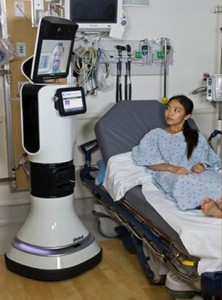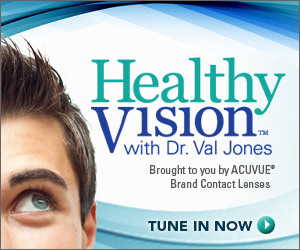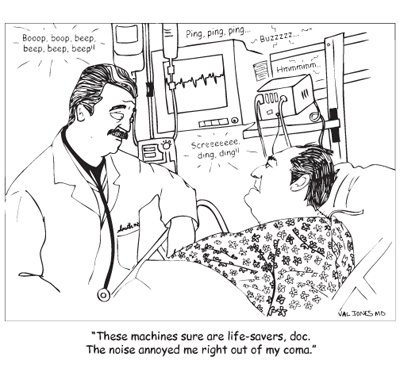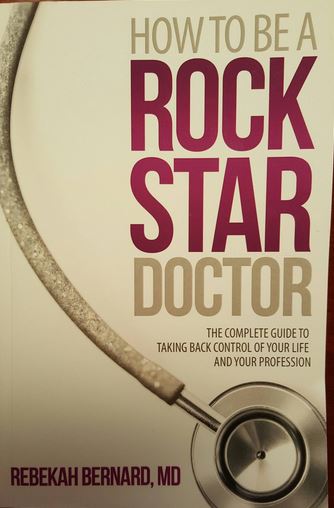October 21st, 2013 by Dr. Val Jones in Opinion
9 Comments »

A "Medical Service Provider"
As I sat in my orthopedist’s exam room, the discussion quickly turned from my chief complaint to his: “I don’t know why I’m doing this anymore,” he said. “Medicine is just not what it used to be, and I don’t enjoy my work anymore. The bureaucracy and regulations are bad enough, but what really gets me is the hostility. My patients are chronically angry and mean. The only comfort I get is from talking to other doctors. Because they all feel the same way.”
Perhaps this sentiment strikes you as the spoiled musings of a physician who is lamenting his demotion from “god” to “man” – reflecting the fundamental change in the public perception of doctors that has occurred over the past ~50 years. Or maybe you wonder if this surgeon’s patients are mean because he is a bad doctor, or isn’t respectful of their time? Maybe he deserves the hostility?
I’ve found this particular surgeon to be humble, thoughtful, and thorough. He is genuinely caring and a proponent of conservative measures, truly eager to avoid surgical procedures when possible. He is exactly what one would hope for in a physician, and yet he is utterly demoralized. Not because of the hours of daily documentation drudgery required by health insurance and government regulators, but because the very souls he has been fighting to serve have now turned on him. Their attitudes are captured in social media feeds on every major health outlet:
Doctors? I no longer afford that kind of respect: I call them “medical services providers.” They and their families and the medical cabal created this mess when they got control of med schools so that the wealth of a nation would remain in the hands of a few medical elites and their families. The very notion that doctors are smarter, more productive, more anything than others is ludicrous. They are among the worst sluff-offs of our society, yet the richest at the same time. It is an unreal world they have created themselves and they are now watching the natural outcome of such a false system.
The very best physicians have always been motivated primarily by the satisfaction of making a difference in their patients’ lives. That drive to “help others” is what makes us believe that all the sacrifices are worth it – the years of training, the educational debt, the lack of sleep, the separation from family, the delay (and sometimes denial) of becoming a parent, the daily grind of administrative burden, the unspeakable emotional toll that death and disease take on your heart… All of that is offset by the joy of changing and saving lives. But when that joy is taken from you, what remains is despondency and burn out.
What patients need to realize is that they have been (and still are) the primary motivator of physician job satisfaction. Patients have the power to demoralize us like no one else – and they need to take that power very seriously. Because if negative attitudes prevail, and hostility spreads like a cancer in our broken system, the most caring among us will be the first to withdraw.
And in the end all that will be left is “medical service providers.”
October 15th, 2013 by Dr. Val Jones in Expert Interviews
No Comments »
 I recently wrote about my experiences as a traveling physician and how to navigate locum tenens work. Today I want to talk about the client (in this case, hospital) side of the equation. I’ve had the chance to speak with several executives (some were physicians themselves) about the overall process of hiring and managing temporary physicians. What I heard wasn’t pretty. I thought I’d summarize their opinions in the form of a mock composite interview to protect their anonymity – I’m hoping that locum MDs and agencies alike can learn from this very candid discussion.
I recently wrote about my experiences as a traveling physician and how to navigate locum tenens work. Today I want to talk about the client (in this case, hospital) side of the equation. I’ve had the chance to speak with several executives (some were physicians themselves) about the overall process of hiring and managing temporary physicians. What I heard wasn’t pretty. I thought I’d summarize their opinions in the form of a mock composite interview to protect their anonymity – I’m hoping that locum MDs and agencies alike can learn from this very candid discussion.
Dr. Val: How do you feel about Locum Tenens agencies?
Executive: They’re a necessary evil. We are desperate to fill vacancies and they find doctors for us. But they know we are desperate and they take full advantage of that.
Dr. Val: What do you mean?
Executive: They charge very high hourly rates, and they don’t care about finding the right fit for the job. They seem to have no interest in matching physician temperament with hospital culture. They are only interested in billable hours and warm bodies, unfortunately. But we know this going in.
Dr. Val: Do you try to screen the candidates yourself before they begin work at your hospital?
Executive: Yes, we carefully review all their CVs and we interview them over the phone.
Dr. Val: So does that help with finding better matches?
Executive: Not really. Everyone looks good on paper and they sound competent on the phone. You only really know what their work ethic is like once they’ve started seeing patients.
Dr. Val: What percent of locums physicians would you say are “sub-par” then?
Executive: About 50%.
Dr. Val: Whoah! That’s very high. What specifically is wrong with them? Are they poor clinicians or what?
Executive: It’s a lot of things. Some are poor clinicians, but more commonly they just don’t work very hard. They have this attitude that they only have to see “X” number of patients per day, no matter what the census. So they’re not good team players. Also many of them have prima donna attitudes. They just swish into our hospital and tell us how they like to do things. They have no problem complaining or calling out flaws in the system because they know they can walk away and never see us again.
Dr. Val: Yikes, they sound horrible. Looking back on those interviews that you did with them, could you see any of this coming? Are there red flags in retrospect?
Executive: None that I can think of. All of our problem locums have been very different – some are old, some are young – they come from very different backgrounds, cultures, and parts of the country. I can’t think of anything they had in common on paper or in the phone interviews.
Dr. Val: So maybe the agencies don’t screen them well?
Executive: Right. I think they probably ignore negative feedback about a physician and just “solve the problem” by not sending them back to the same hospital. They just send them elsewhere – and so the problem continues. They have no incentive really to take a locums physician out of circulation unless they do something truly dangerous at work (medical malpractice). That’s pretty rare.
Dr. Val: I recently wrote on my blog that there are 4 kinds of physicians who do locums: 1. Retirees, 2. Salary Seekers, 3. Dabblers and 4. Problem personalities – would you agree with those categories?
Executive: Yes, but I think that a large proportion of the locums I’ve met have been either motivated by money (i.e. they want to make some extra cash so they can go on a fancy vacation) or they just don’t get along well with others. There are more “problem people” out there than you think.
Dr. Val: This is rather depressing. Have you found that some agencies do a better job than others at keeping the “good” physicians coming?
Executive: Well, we only work with 2 or 3 agencies, so I can’t speak to the entire range of options. We just can’t handle the complexity associated with juggling too many recruiters at once because we end up with accidental overlap in contracts. We have booked two doctors via two different agencies for the same block of time and then we are legally bound to take them both. It’s an expensive mistake.
Dr. Val: Does one particular agency stand out to you in terms of quality of experience?
Executive: No. Actually they all seem about the same.
Dr. Val: For us locums doctors, I can tell you that agencies vary quite a bit in terms of quality of assignments and general process.
Executive: There may be a difference on your end, but not much on ours.
Dr. Val: So, being that using locums has been a fairly negative experience for you, what do you intend to do to change it?
Executive: We are trying very hard to recruit full time physicians to join our staff so that we reduce our need for locums docs. It’s not easy. Full time physician work has become, quite frankly, drudgery. Our system is so burdened with bureaucratic red tape, decreasing reimbursement, billing rules and government regulations that it sucks the soul right out of you. I don’t like who I become when I work full time. That’s why I had to take an administrative job. I still see patients part-time, but I can also get the mental and emotional break I need.
Dr. Val: So you’re actually a functional locums yourself, if not a literal one.
Executive: Yes, that’s right. I have some guilt about not working full time, and yet, I have to maintain my sanity.
Dr. Val: Given the generally negative work environment that physicians live in these days, I suppose that temporary work is only going to increase exponentially as others take the path that you and I have chosen?
Executive: With the looming physician shortage, rural centers in particular are going to have to rely more and more on locums agencies. What agencies really need to do to distinguish themselves is hire clinicians to help them screen and match locums to hospitals. Agencies don’t seem to really understand what we need or what the problems are with their people. If they had medical directors or a chief medical officer, people who have worked in the trenches and understand both the client side and the locum side, they would be much better at screening candidates and meeting our needs. Until then, we’re probably going to have to limp along with a 50% miss-match rate.
October 10th, 2013 by Dr. Val Jones in Announcements, Health Policy
2 Comments »
 I have been an outspoken, and often times exasperated, patient advocate and student of healthcare reform. There is no doubt that the U.S. healthcare system is operating far below its potential in terms of efficiency, effectiveness, and affordability. In fact, an entire industry of policy wonks and consultants have sprung up in both the public and private sectors – all with recommendations about how to “fix” our system. In my opinion, the most insightful suggestions will come from those who are currently doing the work of healthcare (i.e. clinicians) and change will be adopted and promoted most fervently by the young and freshly minted among them.
I have been an outspoken, and often times exasperated, patient advocate and student of healthcare reform. There is no doubt that the U.S. healthcare system is operating far below its potential in terms of efficiency, effectiveness, and affordability. In fact, an entire industry of policy wonks and consultants have sprung up in both the public and private sectors – all with recommendations about how to “fix” our system. In my opinion, the most insightful suggestions will come from those who are currently doing the work of healthcare (i.e. clinicians) and change will be adopted and promoted most fervently by the young and freshly minted among them.
Medical students, residents, and physicians newly in practice now have a place to voice their opinions – The American Resident Project is an ambitious movement to promote fresh thinking from tomorrow’s physician-leaders. I am pleased to be supporting this effort here on my blog and in face-to-face meetings with fellows at medical centers across the country. I hope you’ll bookmark the website and join in the community conversation about how to innovate in the midst of a broken system. This is more than a think-tank for change – the ideas and opinions of young doctors may be our best hope for a brighter tomorrow.
Stay tuned for some fresh ideas in the setting of some healthy talk therapy!
September 27th, 2013 by Dr. Val Jones in Health Tips
2 Comments »
 I’ve been following (and often participating in) fitness trends for decades. From Jim Fixx’s outdoor running to Jane Fonda’s work out videos, to Conan-the-Barbarian body building, to step aerobics, to Tae Bo, to hot yoga, to Zumba, and now CrossFit… America’s exercise pendulum has been swinging wildly across the spectrum of possible physical activities. So have we finally reached a balanced mix of strength and cardio for optimum fitness? Maybe.
I’ve been following (and often participating in) fitness trends for decades. From Jim Fixx’s outdoor running to Jane Fonda’s work out videos, to Conan-the-Barbarian body building, to step aerobics, to Tae Bo, to hot yoga, to Zumba, and now CrossFit… America’s exercise pendulum has been swinging wildly across the spectrum of possible physical activities. So have we finally reached a balanced mix of strength and cardio for optimum fitness? Maybe.
CrossFit is a system of exercise and nutrition (founded in 2000 by Greg Glassman) that claims to “forge elite fitness.” Their Reebok-sponsored annual games boast that the winners have proven themselves to be “the fittest on earth.” CrossFit advocates a mix of aerobic exercise, gymnastics (body weight exercises), and Olympic weight lifting. Workouts are typically short—30 minutes or less—and intense, requiring maximal physical exertion.
I’ve attended multiple regional Cross Fit competitions, watched national games, competed in a CrossFit style competition, and worked out with several CrossFit athletes as well as attempted their work outs (WOD) on occasion, though I am not a member of a CrossFit gym. All this is to say that I’ve spent a good deal of time contemplating the merits of CrossFit, both as an athlete and as a physician trained in sports medicine. And here’s what I think:
Pros:
Difficulty. High intensity interval training (HIIT) is an effective and highly efficient way to improve muscle strength and cardio-vascular endurance. In my opinion, CrossFit’s greatest contribution to the fitness industry is its emphasis on HIIT, something that has not been sufficiently emphasized in the past.
Nutrition. CrossFit emphasizes the importance of healthy nutrition as part of its fitness strategy. This is sorely lacking in other systems/regimens. While I might quibble with some of the more extreme “Paleo” proponents within the CrossFit community, there’s no arguing that a diet rich in fruits and vegetables, lean protein, healthy oils, and complex carbohydrates (no sugars or refined flours) is a healthy way to eat.
Community. Peer support encourages consistency in participation. CrossFit does a good job in building community and making everyone feel welcome. All levels of fitness (and all ages) are welcome to join a CrossFit gym and participate to the best of their ability in the workout of the day (WOD).
Affordability. CrossFit gyms are relatively inexpensive to outfit (less high-tech equipment) and are easy to scale. For this reason they provide greater access to people at all income levels, which is a huge plus.
Portability. CrossFitters learn how to use their own body weight to create challenging exercise routines anywhere, anytime. There is no longer any excuse not to get a good workout in, whether you are traveling and can’t get to the gym or you are too busy to break free from the kids to do a more formal work out.
Cons:
Frequent Injury. CrossFit injury rates are substantially higher than most other fitness regimens. Herniated disks, muscle and tendon ruptures, rhabdomyolysis are not uncommon. In fact, most CrossFit athletes that I know presume that “injury just comes with the territory” and I frequently see Facebook photos of bloody/blistered hands as some kind of badge of honor. I myself sustained a low back injury even when carefully observing my technique during a CrossFit workout, and a dear friend actually ripped off one of the heads of his bicep when attempting an Olympic weight maneuver, while another friend fractured her wrist after falling down during a series of box jumps to exhaustion. Trust me when I say that if you do CrossFit long enough, you’re bound to become injured in some way.
Challenging Technique. Correct exercise form is hard to master, and since many CrossFit moves derive from gymnastics and Olympic weight lifting (sports that take many years to perfect), it is incredibly important to perform movements according to correct mechanical form. Although CrossFit experts strongly agree that good form is the key to safe and effective exercise, the fact is that people don’t always follow directions. In fact, most athletes that I’ve watched at CrossFit gyms suffer from poor form in one or more of their moves – sometimes because of inexperience, and other times because they are too exhausted to perform their final rep(s) correctly and their attention has waned. Functional movement is freer than the usual, controlled weight scenarios in a gym’s circuit training machines. And with that freedom comes the benefit of activating more muscles at a time, but the danger of injury, especially for new initiates or older athletes.
Peer Pressure. The flip side of having a “strong community” that encourages participation, is that the same community may push participants to engage in unsafe exercise practices. I’ve often seen well-meaning CrossFit instructors encourage people to pick up heavier weights than they feel comfortable with in order to push them to become stronger. There is a fine line between healthy encouragement to challenge yourself, and dangerously heavy weight lifting. It’s normal to want to “keep up with the Joneses” to your right and left during a WOD, but when Mr. Jones is a 250 pound tower of muscle, you might not want to be lifting the same weights.
Glorification of the mesomorph. There’s no doubt that committed CrossFitters develop enviably lean, muscular bodies. However, I wince a bit at the tendency for CrossFitters to promote the idea that their way is “THE best way” to be fit, and the bravado surrounding their competitions for “fittest on earth” is exclusionary and unfair. Just because an athlete was born with a different body type, ill-suited to Olympic weight lifting for example, doesn’t mean they can’t be fittest on earth (a rather subjective measure – why not an Ironman as the fittest?) There’s not much variation in the body types of those who are at the top of the CrossFit heap (i.e. large muscle mass, not too short or tall), which speaks to the fact that ultimately this sport is not optimal for all-comers (nor is the position of linebacker on a football team).
My bottom line: CrossFit must be approached with caution, though it provides some excellent HIIT and nutrition principles that can optimize one’s health. If you enjoy strength training (more than cardio or yoga for example) and like camaraderie but can resist the temptation to push yourself into the injury zone, then CrossFit may be for you.
I personally recommend (and participate in) what I would call “CrossFit light” – meaning workouts of similar CrossFit intensity but without extreme weight/maneuvers, and scaling up slowly (especially when new to exercise or a Masters athlete), adding additional cardiovascular training, and eating a diet slightly higher in complex carbohydrates than is generally recommended by strict “paleo” type CrossFitters. And of course, I do not believe that my way is the best or only way to be fit. If you like running, cycling, yoga, Pilates, or even step aerobics – good for you! Aim to be active for an hour/day – and add a little strength training in as you can. If you do that much, you may not be the “fittest on earth” but you’ll be doing more exercise than 96% of Americans!
September 23rd, 2013 by Dr. Val Jones in Health Tips
No Comments »

This actress keeps her dermatologist on speed dial too.
As a light skinned, be-freckled woman with a history of pre-melanoma, I have been sternly instructed to keep my dermatologist on speed dial. Every six months I dutifully return to his office for inspection – nervously eyeing the biopsy tray as I sweat through my paper gown, legs dangling from a vinyl exam table.
In preparation for my most recent trip, I decided to be “an empowered patient” and arrive with a list of general dermatology and skin care questions that could be answered during my skin check. Judging from the near-syncopal episodes that I induced in my dermatologist while describing some of my hygiene practices, I’m not being very good to my skin. In fact, he wanted me to know that at least three products that I currently use are “of the devil.” Just in case you are inadvertently engaging in demonic skin care practices as I was – I thought I’d share what I learned:
1. Dryer sheets. According to my dermatologist, dryer sheets contain “a horrible chemical that no one can pronounce” that becomes “slathered all over your clothing” during the drying process. Although I was fond of the fresh scent and soft texture of my gym clothes, he assured me that heat and moisture was the best way to re-activate the irritating chemicals on delicate skin, virtually guaranteeing a contact dermatitis of the nether regions. So if you’ve been experiencing any unpleasant post-work out skin “issues” – consider dryer sheets as a potential cause.
2. Antibacterial ointments. Personally, I find that over-the-counter antibacterial ointments do a great job of preventing razor bumps. However, my dermatologist says that repeated or excessive use of these products can lead to allergies and colonization with antibiotic-resistant organisms. So… unless you want to be giving MRSA a “come-hither stare,” you might want to opt out of the Neosporin.
3. Battery-operated exfoliating brushes. I’ve seen so many ads for Clarisonic-type products that I figured they would be a reasonable choice for facial exfoliation needs. In fact, this topic may be somewhat controversial since I know other doctors who recommend these products. However, my dermatologist says that they are overkill and might do more harm than good to delicate facial skin, especially if you use any products that have an exfoliating acid included in their ingredient list, or if you use scrub creams. In other words, if you wash your face regularly, you probably don’t need to use additional aggressive cleaning measures.
In addition to the information provided about evil products commonly used by innocent people across America, my dermatologist offered these general tips for healthy skin:
1. You don’t need so much moisturizer. “You don’t need to put on moisturizer every night just because your mother told you to,” he said, bow tie looming large at eye-level. “Women think they need to apply moisturizer multiple times a day, but there is enough moisturizer in sunscreens and anti-oxidant serums to make additional products unnecessary.”
2. Throw away your 10x mirror. “Honestly, no one sees your skin at 10x, so why should you worry about what it looks like so close up? The best way to make your pores look smaller is to quit looking at them under a magnifier.”
3. Use physical block sunscreen every day. Most of the cheaper, spray-on sunscreens use chemicals to scatter light, but zinc-based sunscreens physically block incoming UV radiation. “The most important part of an ‘anti-aging’ regimen is to avoid sun exposure, and the best way to do that is with constant use of physical blocks.”
4. Skin-lightening cream (hydroquinone) can reduce the appearance of sun damage. Hydroquinone is the active ingredient in most skin-lightening creams. It acts to down-regulate melanin production in melanocytes, but can be reversed fairly easily by UV exposure (i.e. sunlight up-regulates melanin production). So even if you’re already pale-skinned, hydroquinone products can even out skin tones and sun spots – but only if you simultaneously commit to aggressive avoidance of UV exposure.
I hope you’ve found these skin tips enlightening (pun intended). I’ll have to think of some other good questions to ask my dermatologist in 6 months from now, during my next cancer screening. Because as an empowered patient, I intend to learn as much as I can in my 15 minutes with the doctor, and then share it with as many people as possible. 🙂



 I recently wrote about
I recently wrote about  I have been an outspoken, and often times exasperated, patient advocate and student of healthcare reform. There is no doubt that the U.S. healthcare system is operating far below its potential in terms of efficiency, effectiveness, and affordability. In fact, an entire industry of policy wonks and consultants have sprung up in both the public and private sectors – all with recommendations about how to “fix” our system. In my opinion, the most insightful suggestions will come from those who are currently doing the work of healthcare (i.e. clinicians) and change will be adopted and promoted most fervently by the young and freshly minted among them.
I have been an outspoken, and often times exasperated, patient advocate and student of healthcare reform. There is no doubt that the U.S. healthcare system is operating far below its potential in terms of efficiency, effectiveness, and affordability. In fact, an entire industry of policy wonks and consultants have sprung up in both the public and private sectors – all with recommendations about how to “fix” our system. In my opinion, the most insightful suggestions will come from those who are currently doing the work of healthcare (i.e. clinicians) and change will be adopted and promoted most fervently by the young and freshly minted among them. I’ve been following (and often participating in) fitness trends for decades. From Jim Fixx’s outdoor running to Jane Fonda’s work out videos, to Conan-the-Barbarian body building, to step aerobics, to Tae Bo, to hot yoga, to Zumba, and now CrossFit… America’s exercise pendulum has been swinging wildly across the spectrum of possible physical activities. So have we finally reached a balanced mix of strength and cardio for optimum fitness? Maybe.
I’ve been following (and often participating in) fitness trends for decades. From Jim Fixx’s outdoor running to Jane Fonda’s work out videos, to Conan-the-Barbarian body building, to step aerobics, to Tae Bo, to hot yoga, to Zumba, and now CrossFit… America’s exercise pendulum has been swinging wildly across the spectrum of possible physical activities. So have we finally reached a balanced mix of strength and cardio for optimum fitness? Maybe.








